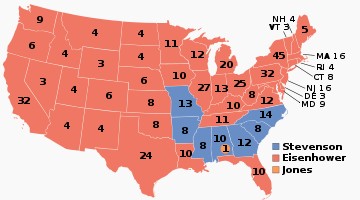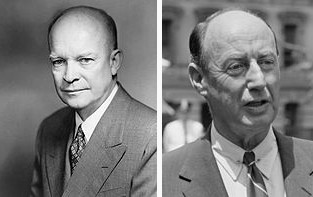
United States presidential election of 1956
Wikipedia | 2013-01-10 13:07
| United States presidential election, 1956 | ||||||||||||||||||||||||||||||||||||||||||||
|
||||||||||||||||||||||||||||||||||||||||||||
|
||||||||||||||||||||||||||||||||||||||||||||

|
||||||||||||||||||||||||||||||||||||||||||||
| Presidential election results map. Red denotes states won by Eisenhower/Nixon, Blue denotes those won by Stevenson/Kefauver. Orange is the electoral vote for Walter Burgwyn Jones by an Alabama faithless elector. Numbers indicate the number of electoral votes allotted to each state. | ||||||||||||||||||||||||||||||||||||||||||||
|
||||||||||||||||||||||||||||||||||||||||||||
The United States presidential election of 1956 saw a popular Dwight D. Eisenhower successfully run for re-election. The 1956 election was a rematch of 1952, as Eisenhower's opponent in 1956 was Democrat Adlai Stevenson, whom Eisenhower had defeated four years earlier.
Incumbent President Eisenhower was popular, but had health conditions that became a quiet issue. Stevenson remained popular with a core of liberal Democrats but held no office and had no real base. He (and Eisenhower) largely ignored the civil rights issue.
Eisenhower had ended the Korean War and the nation was prosperous, so a landslide for the charismatic Eisenhower was never in doubt.
This was the last presidential election prior to the statehood of Alaska and Hawaii, who would first take part as states in the 1960 presidential election. It was also the last election where either one of the major candidates was born in the 19th century.
General election
Campaign
Stevenson campaigned hard against Eisenhower, with television ads for the first time being the dominant medium for both sides. Because Eisenhower's 1952 election victory was due, in large part, to winning the female vote, there were a plethora of "housewife" focused ads. Some commentators at the time also argued that television's new prominence was a major factor in Eisenhower's decision to run for a second term at age 66, considering his weak health after the heart attack in 1955. Television allowed Eisenhower to reach people across the country without enduring the strain of repeated coast-to-coast travel, making a national campaign more feasible.
Stevenson proposed significant increases in government spending for social programs and treaties with the Soviet Union to lower military spending and end nuclear testing on both sides. He also proposed to end the military draft and switch to an "all-volunteer" military. Eisenhower publicly opposed these ideas, even though in private he was working on a proposal to ban atmospheric nuclear testing. Eisenhower had retained the enormous personal and political popularity he had earned during World War II, and he maintained a comfortable lead in the polls throughout the campaign.
Eisenhower was also helped by his handling of two developing foreign-policy crises that occurred in the weeks before the election. In the Soviet-occupied People's Republic of Hungary, many citizens had risen in revolt against Soviet domination, but this quieted with the formation of a new government. Then in Egypt, a combined force of Israeli, British, and French troops invaded to topple Gamal Abdel Nasser and seize the recently-nationalized Suez Canal. While resolving the latter crisis rapidly moved to the United Nations, Eisenhower's actions were limited,and the Hungarian revolt was brutally crushed within a few days by re-deployed Soviet troops. Eisenhower condemned both actions, but was able only to pressure the western forces to withdraw from Egypt. While these two events led many Americans to rally in support of the President and swelled his expected margin of victory, the campaign had been seen differently by some foreign governments. The Eisenhower administration had also supported the Brown v. Board of Education ruling in 1954; this ruling by the U.S. Supreme Court ended legal segregation in public schools. As a result, Eisenhower won the support of nearly 40% of black voters; he was the last Republican presidential candidate to receive such a level of support from black voters.
Eisenhower led all opinion polls by large margins throughout the entire campaign. On election day Eisenhower took over 57% of the popular vote and won 41 of the 48 states. Stevenson won only six Southern states and the border state of Missouri, becoming the first losing candidate since 1900 (William Jennings Bryan vs. McKinley) to carry the Show-Me-State (Missouri would not vote for the losing candidate in a presidential election again until 2008). Eisenhower carried Louisiana, making him the first Republican presidential candidate to carry the state since Reconstruction in 1876.
Share this page




















